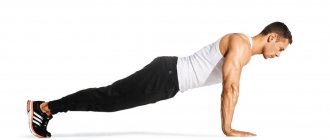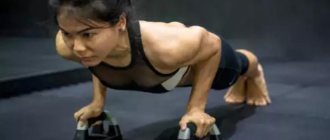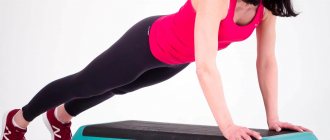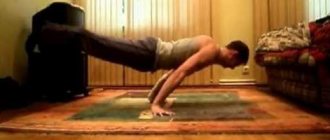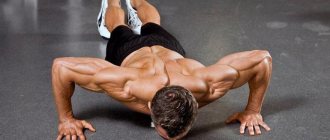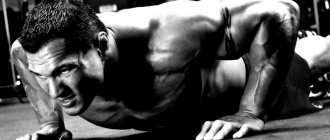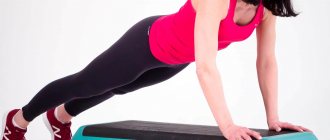There are many sports exercises that are highly effective and efficient. One of them is push-ups , which are recommended to be done not only by adults, but also by children. You can start doing push-ups from the age of six. This exercise is especially necessary for adults, since physical activity decreases over the years.
Do you need to do push-ups every day?
It is important to understand that push-ups are an exercise for which the body spends energy in the same way as any other physical activity. Moreover, this is a basic, multi-joint exercise that uses several muscle groups: chest, shoulders, triceps, as well as the back, biceps, abs and legs as stabilizer muscles. It's unlikely that you do deadlifts or squats, which are also compound exercises, every day. Therefore, we can conclude that push-ups every day or every other day as a full-fledged workout will not only not bring benefits, but, on the contrary, will quite quickly lead the body to a state of overtraining.
How to do push-ups correctly?
The exercise brings maximum benefit only if the execution technique is followed. To do push-ups correctly, you need to adhere to the following scheme of actions:
Take starting position
Lie down on a horizontal, flat surface. In this case, your hands should be shoulder-width apart, and your feet should be shoulder-width apart. You need to make sure that your toes rest on the floor and your palms point up.
Perform a push-up
While inhaling, the arms bend at the elbow joints, the body lowers down so that it forms an even and straight line, which should be uniform and not break.
Any deflection violates the technique of execution. If the body bends, then push-ups become easier to perform, but this makes them ineffective.
Take the original position
Returning to the starting position is performed while exhaling.
There are many varieties of push-ups. This allows you not only to diversify your workouts, but also to choose, after trying different, the most optimal options for yourself. There are over fifty types of this exercise, but it is enough to dwell on the most popular ones.
Push-ups can be lightened or weighted. It depends on the position of the arms and legs. Using third-party equipment in an exercise can make the process easier or, conversely, complicate it.
Daily push-ups as exercise
As we found out earlier, it is not advisable to carry out a full workout of push-ups every day. It’s another matter if you do push-ups every day as exercise.
From early childhood we were taught that we need to do exercises in the morning in order to be toned and in a good mood all day. And push-ups have always been one of the elements of this exercise, along with squats and various arm swings. It is push-ups that tone the muscles of the upper body. Below we present several arguments that will help you understand why it is so useful to do push-ups every day in the morning.
- Increased endurance;
- Improving the functioning of the respiratory and circulatory systems;
- Warm-up muscles and joints that have been “stagnant” overnight;
- Muscle tone, giving a boost of energy for the whole day.
It is important to understand that in the morning it is enough to perform 2-3 approaches of 60-80% of your maximum result in push-ups or just, say, 15-20 times.
This will be enough to fill the muscles with blood and oxygen. There is absolutely no need to overload your body, because there is still a whole day ahead, and you will definitely need strength.
Light push-ups
Best suited for beginners. The relief push-up complex consists of the following exercises:
Wall
The easiest push-up. To perform it, stand at a distance of 50 cm from the wall, support yourself with your hands, raise your heels, bend your arms as you inhale, approach the wall, and take the starting position at the exit.
Bench or step
To make push-ups easier and simpler, you can rest your hands on a bench or step.
Support on your knees
If you press your knees rather than your toes into the floor, then doing push-ups becomes much easier.
This complex is ideal for initial muscle training, in preparation for stronger loads in the future.
What happens if you do push-ups every day until muscle failure?
Of course, someone will think that 2-3 sets of 15-20 push-ups is too little and will decide to perform each approach until a state of complete muscle failure. But such loads for several days in a row will not bring any benefit, but on the contrary, will harm the body.
Some of the negative consequences of daily muscle failure include:
- Overfatigue and muscle exhaustion, which in turn will lead to a decrease in muscle volume;
- Constant feeling of fatigue in the shoulder girdle;
- Risk of injury and joint diseases.
How many push-ups should you do?
You should exercise three to four times a week. This will give the muscles the opportunity to rest after each workout. Not only the intensity of the training matters, but also the number of push-ups. A special table allows you to understand the latter. It presents a complex designed for three and a half months, training in which consists of 5 approaches:
| A week | Number of push-ups |
| first | 20/20/15/15/10 |
| second | 25/25/20/15/10 |
| third | 30/30/25/20/15 |
| fourth | 35/30/25/20/15 |
| fifth | 40/35/25/20/15 |
| sixth | 40/40/30/30/20 |
| seventh | 45/40/35/35/25 |
| eighth | 45/45/35/35/25 |
| ninth | 50/45/35/35/30 |
| tenth | 50/50/40/40/35 |
| eleventh | 55/50/40/40/35 |
| twelve | 60/55/40/40/35 |
| thirteenth | 60/60/45/45/40 |
| fourteenth | 65/60/45/45/40 |
| fifteenth | 65/65/45/45/40 |
The program allows you to increase the number of push-ups performed in one workout to 260. To increase the complexity of the training, you should not limit yourself to the basic execution. The complex can be varied with push-ups using weights, with a narrow grip, with emphasis on chairs.
Igor August 24, 2016
Push-up pattern for every day according to GTO standards
Often teenagers, and sometimes adults, want to increase their records in push-ups in order to meet the GTO standards.
The first thing you should pay attention to is the technique of performing the exercise. When passing the TRP standards, great attention is paid to this aspect. It is important to be able to keep your entire body in a single straight line, and spread your elbows no more than 45 degrees relative to the body.
Once you have mastered the technique, you can begin to work on increasing the number of push-ups by training according to one of the schemes below.
Scheme 1
You need to do 2-3 sets of 15-30 push-ups every day, keeping your bodies strictly in a position that complies with the GTO standards, pausing for 0.5-1 second with each push-up. This approach ensures an even load on the pectoral muscles, shoulders and triceps.
Read about how to do push-ups to pump up your triceps →
Scheme 2
It is necessary to do push-ups in different variations:
- The elbows are pressed to the body (the main load falls on the triceps and the front deltoids);
- Elbows apart more than 45 degrees, wide push-ups (the main load falls on the pectoral muscles);
- Classic push-ups according to GTO standards;
- Fist push-ups, which allow you to increase the range of motion.
Each version of push-ups can be performed in 1 set of 10-15 repetitions or in 3 sets of 5-7 repetitions, alternating exercises.
Read more about all types of push-ups →
This scheme allows you to more comprehensively and comprehensively load the muscles of the shoulder girdle.
Weighted push-ups
Much more effective than the basic ones. Strengthening occurs by alternating various types of push-ups:
On fists
Reducing the area of support makes it more difficult to perform, but allows you to train your knuckles.
At your fingertips
Suitable for those who are well prepared and trained.
On one hand
The emphasis is on one hand, while the other is behind the back. Due to this, there is a significant increase in load.
With emphasis on a bench or step
It is more difficult to perform than on a horizontal plane. As the height of the bench increases, the center of gravity shifts even more, and, therefore, more effort is required.
With chairs
One chair is placed under the feet, two - under the arms. You can limit yourself to using only a couple of chairs on which you place your palms. Doing push-ups this way is much more difficult, but also more effective.
With weights
Increases the load on the back muscles. You can use a special vest, weights from a barbell, dumbbells, or a backpack with a load in it.
Techniques such as changing the distance between the hands, clapping, or changing the support can make push-ups on your fists more difficult. Another option is to do a circuit exercise. To do push-ups in this way, after lowering the body, the weight is moved to one hand, moving to the center, the load is transferred to the other hand, and then returned to the starting position.
These exercises are great for doing not only in the gym, but also at home. This will not affect their effectiveness in any way.
Remember:
It is best to start doing push-ups with weights after mastering the basic classical execution scheme. You shouldn't chase quantity. Much more important is quality - correct technique.
How to learn to do push-ups. And what types of push-ups are there?
How to do push-ups correctly and why is it necessary?
At home, even without any special equipment, it is very easy to improve the physical qualities of muscles. And the most effective exercise for developing almost all muscle groups is push-ups while lying down. That is why in the army strength is primarily determined in this way.
Benefit and application. First of all, push-ups are responsible for the development of various muscle groups in the arms and chest. But when done correctly, the muscles of the abdomen, back and legs are significantly strengthened. Of course, like all physical exercises, push-ups stimulate the human body to work harder, and it is necessary to calculate its capabilities.
Be careful with loads. Don't exercise if you're not healthy. Most types of respiratory diseases, including infectious ones, place a serious strain on the heart, and, accordingly, any physical activity is strictly contraindicated. If you have a diseased heart, you should not allow even the slightest overload of the circulatory system.
Photo: Depositphotos
Execution system. It is best to do push-ups in several approaches with a short break - the more, the better, and you should try to have approximately the same number of movements in each approach.
If you know your norm, then reduce the number of push-ups performed by about 20%, and each new day increase your quantitative productivity by one. Don't push yourself to the point of exhaustion at first. It’s better to do four times 25 push-ups than two times 50. But you shouldn’t relax completely - do the exercises until you feel moderate fatigue in your muscles.
For busy people, of course, it is best to perform the maximum load once or twice, for example, in the morning or evening. But if possible, then it is better to do this all day - at different intervals and according to your mood: you can determine for yourself a daily norm calculated for 24 (16) hours.
Correct execution. There is hardly much new to say here. The main thing is that the body is straight throughout. You must try to ensure that your back does not arch downward and your buttocks do not stick out upward. The head looks to the floor. The deeper the landing, the better, ideally you need to touch the support with your chest or nose (just be careful). Breathing is systematic: when lowering the body, inhale, when rising, exhale.
Photo: Depositphotos
Execution technique. Be that as it may, push-ups are an exercise that can be performed in different ways.
Let us first analyze the position of the supporting parts of the hand - the hands . Small children and women usually perform push-ups on the inside of the palm; the simplest type is that if the fingers point forward, the hands automatically become in the most comfortable position. But when doing this, there is practically no benefit for the muscles of the hand itself.
The simplest and most common hand position among men is push-ups with fists . In this case, the fist is placed on two or three phalanges. Here there is a development of the muscle group of the fingers and the side of the palm that is closer to the thumb. Well, and, of course, the skin on the joints and phalanges hardens, the fist acquires the most favorable position for striking - this greatly helps people who have to fight (at least in the long term).
Photo: Depositphotos
A more complex type is push-ups on the edge of the palm (in this case, the side of the palm opposite the thumb develops) and on its back side. Of course, doing push-ups on the back of your hand is painful at first, and it takes practice to get used to it. But over time it will become easier. This type of push-up helps to significantly strengthen the muscles in the area of the metacarpal bones, and the hand itself will become hard and less sensitive to external influences, which is extremely useful in extreme and difficult (physically) situations, be it a parachute jump, mountain climbing or kayaking .
Photo: Depositphotos
Well, the very last level is finger , this is really quite difficult. At first it is better to use all five fingers, gradually removing one at a time. Most likely, the entire weight of the body will act on the thumb, and the fingers themselves will bend downward - you will get something like a “spider”. But try to keep your fingers straight or rounded upward. You can consider yourself a very persistent person if you manage to do push-ups or at least take a lying position without the participation of your thumb.
And push-ups on one finger (middle or index) are aerobatics, which not everyone can do. By the way, finger push-ups are very helpful for people who play the guitar, violin, piano or deal with typing on the keyboard - trained fingers will acquire hardness, flexibility and speed, and they will hurt less when pinch the strings. Push-ups on the fingers are ideal for training a direct blow - the fist becomes “iron”.
Now about the position of the rest of the hands. Since push-ups are an exercise similar in effect to the bench press, in addition to the arms, the pectoral muscles are also involved. Therefore, what will swing depends on the position of the arms (among the muscles of the arm, the triceps are trained the most, although most of the load goes on the shoulder and a little on the biceps).
Photo: Depositphotos
The standard position is with your hands shoulder-width apart, elbows pointing at a 45-degree angle from your body. This is the easiest way to do push-ups; the load is distributed evenly. If you place your hands wider than your shoulders and spread your elbows to a right angle to the body, the deltoid muscle and pectoralis major will be involved. But if, on the contrary, you place your hands as close as possible, with your elbows parallel to your body, then the load will go to the triceps and pectoralis minor.
You can also change the inclination of the body relative to the surface to achieve different results. At the same time, if the head is higher than the legs, the lower part of the chest sways, and if lower, then the upper part along with the abdominal muscles.
Alternative push-up methods. It is very useful for the development of arms to do push-ups on one arm - it is difficult if you are not used to it, but the training is worth the results (a little advice: the wider you spread your legs, the easier it will be). Also, the effect of the exercise is enhanced several times if a person sits on your back or if you put one leg on the other.
Photo: pixabay.com
You can also practice push-ups with clapping - first one clap, then you can do two, three, clap behind your back, etc. This develops reaction and dexterity. If you want to focus on breathing training, then do push-ups while running, and consistently do about 15-20 push-ups over a certain distance.
Play sports, develop strength, agility and reaction - your body will only thank you!
Tags: physical strength, push-ups, physical activity, exercise


